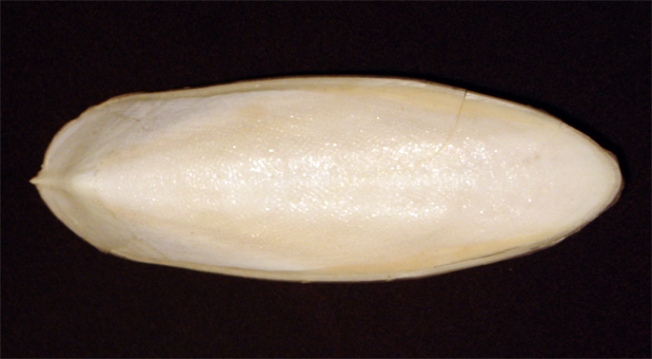It remains soft tissue season – the article for Wednesday is Fossil Cuttlefish Has Original Tissue.
Your context is a paper in PLoS ONE called Characterization of Organics Consistent with β-Chitin Preserved in the Late Eocene Cuttlefish Mississaepia mississippiensis. Chitin is a protein polysaccharide which, according to Wikipedia, “[i]n terms of structure, chitin may be compared to the polysaccharide cellulose and, in terms of function, to the protein keratin.” It’s the construction material of exoskeletons, such as those of crabs and insects. As usual with discussing ‘soft tissue’ finds, mineralised chitin in fossils is understandably quite common – what is interesting here is that the ‘original tissue’ remains, rather than a stone in the same shape. According to the paper:
Ancient chitin has been recovered from both terrestrial and marine arthropods, but prior to this study had not been recovered from fossil marine mollusks.
And:
Detection of chitin in fossils is not frequent. There are reports of fossil chitin in pogonophora, and in insect wings from amber [4]. Chitin has also been reported from beetles preserved in an Oligocene lacustrine deposit of Enspel, Germany [5] and chitin-protein signatures have been found in cuticles of Pennsylvanian scorpions and Silurian eurypterids [6].
Wikipedia – or at least the author of a short section on the Chitin page – would have you believe that “The oldest preserved chitin dates to the Oligocene, about 25 million years ago.” Their reference for this is a paper not mentioned here, although reference 5 above is of the same age (this paper is reporting on a fossil nearly 35 million years old). The ‘chitin-protein signatures,’ I take it, don’t count here.
To begin Mr Thomas’ article:
Cuttlefish are mollusks that look somewhat like squid. They have an internal, hard, supportive structure with soft organs around and inside it. This resilient “cuttlebone” is made of cleverly woven strands of a biochemical material called chitin and mixed with a hard biomineral called aragonite.
The creationists never miss a moment to imply design beyond the abilities of the ‘random evolutionary processes’ they so disdain. He does not chose to justify the claim in any way, but that’s not the point of the article.
A team of paleontologists found a supposedly 34 million-year-old fossil cuttlebone that still had both the original aragonite and chitin. This is significant, because one might expect the hard aragonite to persist in the fossil record, but not the organic chitin or protein. The chitin, which is made of sugars tightly bonded into molecular chains, would have spontaneously degraded and been long gone after only thousands of years.
The researchers compared the fossil cuttlebone, found in a Mississippi clay deposit, with modern cuttlebone chitin, and their results showed a “shortening of the chitin strands,…the breakdown of chitosan [chemically altered chitin],… and loss of hydrogen bonds.” Thus, the chitin has been falling apart, as would be expected based on chitin biochemistry.
Well there you go – it doesn’t look young, it’s just there, somewhat better preserved than you might expect but still degraded.
(Skipping down past a “If this fossil cuttlebone was deposited during Noah’s Flood, then its partly decayed chitin fits well with the Bible’s chronology.” etc. I thought the flood ended at the K-T boundary?):
Original chitin has rarely been reported in fossils. But it’s unclear if that is because it is not actually present, or because it is not expected to be there—and as a result is hardly ever even investigated.
Not exactly. If it was always that easy to find chitin then everyone would be doing it, and it would not be “controversial” as the introduction stated that fossil organics in general are. Additionally, consider publication bias – if you search for chitin and find none, you are somewhat less likely to publish. As usual, Mr Thomas gives nothing to support his assertion that nobody is looking. Again, everyone would be doing it if it were easily doable – not just for the fame, but for the things that they could tell us about the past.
The same goes for radioactive carbon-14. Few scientists have investigated its presence in the fossil record. Like chitin or protein, all the carbon-14 in organic material should have been eliminated after only thousands of years of spontaneous decay. However, it is abundant in coal, oil, and fossils throughout the geologic column.
For the last time, that’s because it decays not to zero but to a background level, which the creationists then detect and announce that it shows that it’s not as old as claimed.
Another reason the cuttlebone chitin was unexpected is that chitin-eating bacteria degrade it in a matter of days in aquatic ecosystems. But even if chitin is kept sterile, it spontaneously decays, just like other biomolecules such as DNA and proteins.
B.T. gives two cites for the first sentence – but the paper covers that in a section called “Mechanisms for preservation.” He gives nothing to support the second.
Despite the belief that fossils represent millions of years, the rigorous tests performed by these PloS ONE authors verified that this cuttlebone contained original endogenous chitin. And that means that it, and very possibly all the fossils found near it, are not as old as evolutionary history says they are.
Or, perhaps, that chitin can last a few million years if sufficiently protected from bacteria and the elements. Occam’s razor and all that.


Pingback: Forgive Me If You’ve Heard This One Before… « Eye on the ICR
Small nitpick: chitin is not a protein. It’s an oligosaccharide used for structure, like cellulose.
Nitpicking the nitpick – chitin and cellulose are not oligosaccharides, but polysaccharides. Ruddy great big molecules
You learn something new every day… Fixed.
Pingback: Creationist abuse of cuttlefish chitin | Pharyngula